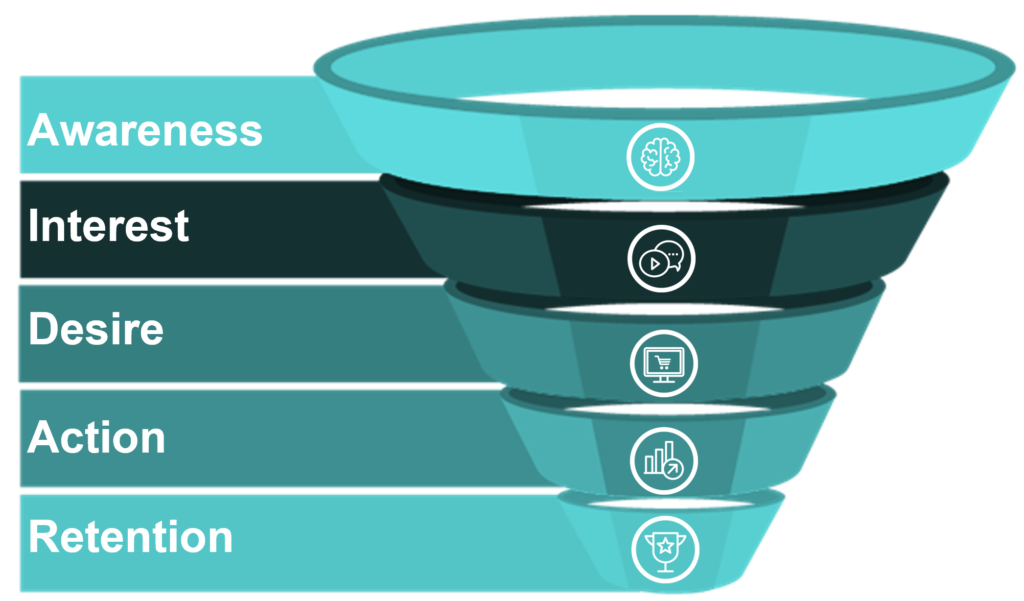
![]() Insights
Insights
When it comes to attracting and converting B2B leads, a solid content marketing strategy can be a brand’s biggest weapon.
However, it takes more than producing ad hoc blogs or using standard product copy to ensure your content marketing strategy is successful – particularly if you are in the B2B industry.
B2B purchases can involve up to five or more decision-makers depending on the cost and strategic importance of a purchase. These factors also impact how long it takes before a B2B customer buys, and it may be months of researching before a decision is made to purchase a product or service which has a high cost or significant strategic importance.

Having a content marketing strategy which is tailored towards these decision-makers and the specific questions they want to know before making a purchase is therefore crucial if you are to build up trust and ultimately convert.
Before you set out to create a content strategy, you need to define who are your key decision-makers and what are their unique needs. This will help you to create personas and map out the customer journey, which highlights what channels you should be posting content on.
Once you have this information, it’s time to create a content marketing strategy which reaches your customers at all stages of the sales funnel.
The sales funnel represents the path people take when buying a product or service – from learning about the various options available, through to becoming a repeat customer.
The type of content which is useful to a person depends on where they are at in the sales funnel. In this blog, we run through the content needed at each stage of the funnel to help move prospects to conversion. For help mapping your own customer journey, download our whitepaper.

During this stage, a person is looking for a solution to an issue they have. This can vary – from a chief technology officer looking for a new teleconferencing solution, to a restaurant chain looking to become more environmentally friendly.
At this stage, the person is unlikely to know exactly what it is they are looking for, so will be asking (or searching for) top-level questions – such as ‘how can businesses be more eco-friendly’.
Content at this stage needs to provide a top-level answer to the searcher’s problem; for B2B, this means emphasizing the business’ pain points and providing the information required so the business can proceed with eliminating these points.
For the purpose of this blog, we will use a CRM software provider that wants to attract new leads through their website. Searches at this level may look like ‘why use a CRM?’ and ‘how to choose the right CRM software for your needs’.
The type of content used at each stage of the sales funnel can vary – there is no right or wrong. However, most of the people at this stage are only lightly researching so information should be easily accessible. ‘What is’ and ‘why’ blog posts, social media posts, short videos and infographics/ visuals are all easy to consume content types that do well as this stage.
Once a decision-maker has identified the solution to their problem, they need to identify who or what provides the best option. The middle funnel is all about evaluating the options available and seeing who meets their needs best.
For B2B purchases, decision-makers tend to spend a lot of time in this research phase – especially for purchases which have high strategic value or high costs. The lead time for these type of purchases can be months, with the decision-maker exploring all their options thoroughly.
Because of the amount of time spent in this stage, your B2B content marketing strategy needs to ensure there is plenty of middle funnel content which will build trust and establish your brand as the industry leader.
Searches at this level may look like ‘how to create an effective customer journey map using your CRM data’, ‘how to create CRM audience segments’ and ‘how to evaluate your VIP customers’.
More in-depth and authoritative content is needed at this stage. Whitepapers, downloadable reports, webinars and downloadable toolkits are all useful resources which can help persuade decision-makers that you are the best in the industry. For blogs in this stage, look at how to guides, in-depth product overviews and service comparisons, rather than top-level content.
Service pages, product descriptions, ‘about us’ pages and FAQs all play a part in the middle stage, too. These need to be both optimized for online visibility, and to ensure that any customer queries are answered.
When the decision-maker is ready to buy, they enter the bottom stage. At this point, there may still be multiple contenders, so content at this stage needs to prove that you are the best option out there.
The funnel does not end once a decision-maker makes the purchase. Providing ongoing value to your customers through exclusive content, such as training, webinars or reports, can help to nurture the relationship and ensure they continue to feel you are the best solution out there.
Searches at this level may look like ‘CRM software pricing’, ‘CRM software for small businesses’ and ‘CRM solutions for enterprises’.
Case studies, testimonials, consultations and free trials can all help to turn a lead into a customer. Ensuring you have strong product pages with CTAs is also crucial.
There are several tools and methods available to help businesses establish what content they should be creating.
The first step is to conduct a content audit on your website. This involves assessing all onsite content to see where it fits in the customer journey and how well it performs. Carrying out a content audit will help you to see where the gaps are, so that you can prioritize stages which have less content. It will also highlight any topics and themes which work well with your audience that can be expanded on.
Conducting keyword research helps to establish what your audience is searching for, and therefore what content you should be creating.
You will need to consider both search volumes and search intent when identifying which keywords to target. Words and phrases with high volume of searches are highly competitive, which means it is harder to appear organically for these queries. A more long-term strategy encompassing both onsite content creation and optimization, and offsite content and link acquisition, is often needed for these terms. Targeting terms with low or medium competition will get results quicker.
If you are struggling to think of the exact questions your audience might be asking around key terms you want to target, tools like Answer the Public highlight what it is your audience is searching for.
In addition to knowing what your audience is searching for, you need to know why they are searching for it – what is the search intent? Search engines aim to deliver the most relevant result for a person’s query, and to be the most relevant result, your content needs to give the user what they want. By considering search intent when creating your content, you improve the relevance of the content.
You’ve audited your own site, now you need to audit your competitors’. Conducting a competitor analysis can draw your attention to topics your audience is interested in, that you should be covering. Identify the strengths and weaknesses in your competitors’ content and use these insights to create strong, compelling content. You can also find opportunities to rank for keywords where your competitors have poor organic visibility.
Your first-party data is valuable source of information about what content your audience is engaging with. From site search to ads with a high click-through rate, analyzing your first-party data can give you a stronger view of what it is your customers want to know. We’ve delved deeper into sources of first-party data you can use to inform your content strategy here.
This blog is part of our wider B2B Playbook that is designed to help B2B businesses with all aspects of their digital marketing from leveraging data, acquiring more traffic, creating assets that resonate and succeeding internationally.
In the traffic section. we take a look at your paid search and organic methods to grow your reach to get the right traffic to turn into more conversions.
Want the latest marketing insights delivered to your inbox?Sign up to our newsletter

![]() Insights
Insights

![]() Insights
Insights

![]() Insights
Insights